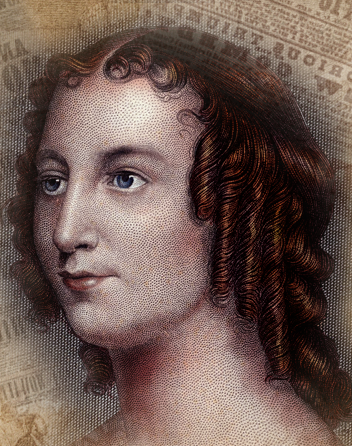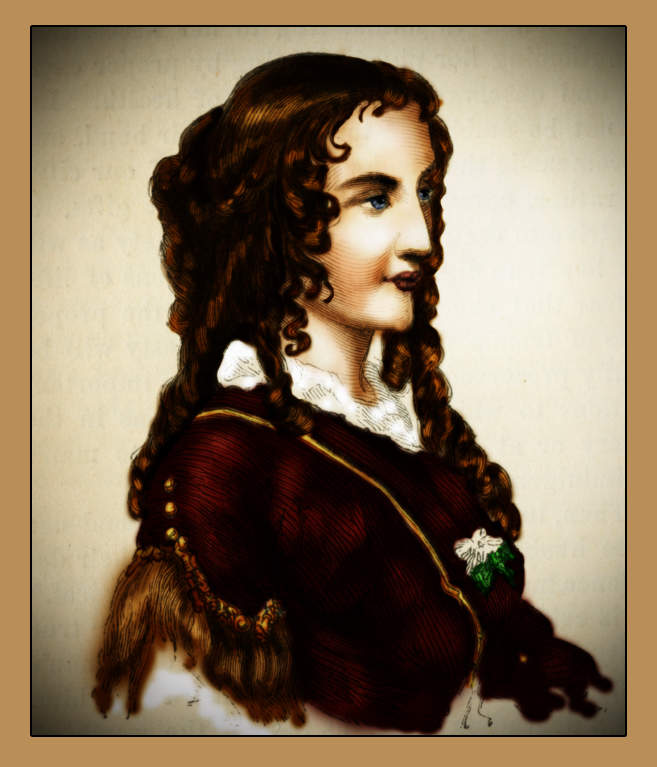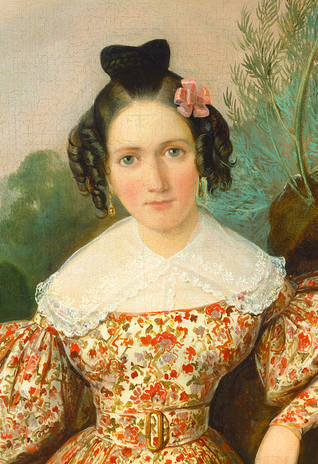
Childhood and Youth
Anna
Cora Ogden Mowatt Ritchie was born in Bordeaux, France, March 5, 1819.
She was the tenth
of the fourteen children of Eliza Lewis and Samuel Gouveneur Ogden.
Ogden (1779-1860), a
New York merchant who was peripherally involved in the failed effort of
Venezuelan patriot
Francisco de Miranda to liberate South American from Spanish rule, was
at the time of Anna
Cora's birth residing in France to act as an agent for foreign
exporters. Eliza Lewis
Ogden (1785-1836) was the granddaughter of Declaration of Independence
signer Francis
Lewis. In accordance with French law, Anna Cora and three of her
sisters became French
citizens shortly after their birth.
|
|
The Ogden family
returned to America in 1826 on the
ship Brandt when Anna Cora was six years old. The
boat was wrecked by a storm. One of her brothers was lost at sea in
this storm. Anna Cora claimed that the respiratory problems that were
to plague her the rest of her life started as a result of her prolonged
exposure to the elements while the family awaited rescue.
She was interested in the stage even as a child of five. Anna Cora played her first role that year, appearing as a judge (with no lines to speak) in a production of Othello that her older brothers and sisters put on for her parents in their home. She wrote poetry from an early age and read all of Shakespere's plays before she was ten. When she was fourteen, she staged and starred in a translation of Voltaire's Alzire in her Flatbush home. |
Anna Cora attended several private schools in New York in addition to instruction by tutors at home. By far her most ardent teacher was James Mowatt (1805-1849). Mowatt, a prosperous New York lawyer, had originally come to the Ogden household as a suitor of Anna Cora's older sister Charlotte. His interest turned to fourteen-year-old Anna Cora. He became a frequent visitor and took over the direction of Anna Cora's education, creating reading lists for her and discussing the books she read. In 1834, one year before Anna Cora was to debut in New York society, Mowatt persuaded her to elope with him. They were married on October 6, 1834, by a French minister who performed the ceremony in French. James Mowatt was twenty-eight years old and Anna Cora was only fifteen. Anna Cora wrote of her elopement:
What could a girl of fifteen know of the sacred duties of a wife? With what eyes could she comprehend the new and important life she was entering? She had known nothing but childhood -- had scarcely commenced her girlhood. What could she comprehend of the trials, the cares, the hopes, the responsibilities of womanhood? I thought of none of these things. I had always been lighthearted to the point of frivolity. I usually made a jest of everything -- yet I did not look on this matter as a frolic. I only remembered I was keeping a promise. I had perfect faith in the tenderness of him to whom I confided myself. I did not in the least realize the novelty of my situation.
The Mowatts had no children. One biographical sketch characterizes James Mowatt as "more like a doting father than a husband."
After their marriage, Mowatt purchased a pre-revolutionary mansion located on a twenty-acre country estate in Flatbush, Long Island. The couple named the estate Melrose. James Mowatt played the role of instructor to his child wife. He continued Anna Cora's studies in English, French, Spanish and music. A journal of critiques and comments she kept at the time indicates she read between ninety and one hundred books yearly under his direction.
Mowatt published a historical romance in verse that Anna Cora had written at age seventeen using the pseudonym "Isabel." The title was Pelayo, or The Cavern of Covadonga (1837). Inspired by Schlegel's "Lectures on Literature," Anna Cora decided to write an epic poem. Pelayo is a poetical romance in six cantos, based on the history of the successor of Roderick the Goth, who in 718 was chosen the first king of the Asturias. The poem shows influences of Byron, Southey, and Halleck.
In her preface, Anna Cora pleaded for the indulgence of her critics:
In this "Golden Age," (or age of gold) I should indeed be presumptuous to suppose such "unprofitable stuff" as rhymes could ever be vendable -- unless, indeed, with patched robe of many hues, and killing Gipsy bonnet, I myself went singing them about the streets; for, you see, I have not even afforded gilt edges to make the pill go down; -- but -- if it will enhance their humble value, be it known to those that take interest in them, that both Dedication and Tale were written and finished before Isabel had completed her seventeenth year; and the only hasty revision they ever had, previous to being put in the printer's hands, was immediately after. -- I am as conscious of their innumerable faults as the severest judge could be; yet those who look with lenient eyes may again hear from Isabel.
|
Incensed at the unfavorable notices from newspaper critics that appeared despite her plea and prompted by Byron's "English Bards and Scotch Reviewers," Anna Cora wrote (still using a pseudonym) a verse response entitled Reviewers Reviewed, which James Mowatt also had published in 1837. In this poem, she creates a fictive Court of Justice where the spirits of Justice, Prudence, Ambition, and Truth try critics George P. Morris (of the New York Mirror), James Watson Webb and Mr. Daniels (of the Courier and Enquirer), Colonel Stone (of the Commercial Advertiser), and Lewis Gaylord Clark (of the Knickerbocker). At one point she compares Mr. Webb to a spider: Welcome, all-conquering Webb! that gossamer name, I agree with other commentators who have noted that although by no means a great poem, Reviewers Reviewed is a far more passionate and original piece of writing than the work it defends. |
 Young Anna Cora Mowatt
|
At this time, Anna Cora developed symptoms of tuberculosis. Believing a change of climate would provide relief, the Mowatts scheduled a sea voyage to Europe. They lived abroad for nearly three years. During this time Anna Cora took German and voice lessons from a singing teacher. She also witnessed performances by two of the most famous and respected actresses of that day: Madame Vestris and her troupe in London and the great tragedian Rachel in Paris. Anna Cora later submitted articles based on her European experiences and observations to several American periodicals. "Bridal Customs of the Northern Germans" was published in The Ladies' Companion (edited by Sarah Josepha Hale), July, 1841, and "Usages and Manners of the North Germans" appeared in the October, 1841, issue of the same magazine. "A Bridal in Germany" and "Dancing Among the Germans" both appeared in Epes Sargent's Sargent's Magazine in May and April of 1843.
While in France, James Mowatt developed an eye ailment that effectively blinded him for four months. To amuse herself during his confinement, Anna Cora wrote a six-act play entitled Gulzara, or the Persian Slave. The play was designed for an all-female cast consisting of herself and three of her younger sisters. She planned to perform Gulzara at a grand ball celebrating the Mowatts' return to New York. Anna Cora commissioned a prominent French scene painter to create six backdrops, one for each act.
 |
Gulzara, the Persian slave of the title, is captured by the men of Sultan Suliman for the Sultan's harem. She longs to return to Hafed, the man with whom she is in love. Ayesha, the wife of the fisherman Rustapha, has been ill-treated by the sultan. During the ruler's absence, she retaliates by kidnapping his son, Ammarth. Gulzara is accused of the crime and thrown into prison. In the meantime, the sultan sends a letter home saying he has been victorious in battle and is returning to marry Gulzara. The sultan, when he returns, turns out to be Gulzara's lover, Hafed. Gulzara was presented by Mrs. Mowatt and her sisters at Melrose on October 17, 1840. A large circle of friends from New York's social elite attended. In the audience was Epes Sargent (1813-1880), associate editor of The New World (New York). He was so impressed by the play -- and Anna Cora -- that he printed the entire script of Gulzara in that paper. Gulzara was the first of Anna Cora Mowatt's works to appear under her own name. Continued degeneration of his eyesight forced James Mowatt to abandon his law practice. He briefly entered into a partnership in a publishing firm. Anna Cora published several works with this firm including a biography of Goethe (written under the pseudonym Henry C. Browning) and two novels The Fortune Hunter; or, The Adventures of a Man about Town and Evelyn; or, A Heart Unmasked (both published under the name Helen Berkley). The Fortune Hunter won a $100 prize in a contest sponsored by The New World. The book achieved extensive sales, a number of editions, and translation into German. The novel tells the story of Augustus Brainard, who having spent his fortune is introduced into New York society by Ellery, a "man about town," who hopes to help his friend to make a profitable marriage. At one point Ellery advises Augustus that Niblo's is unquestionably the place to go since
The Fortune Hunter is an attempt at satire upon New York society and romantic sentimentalism, a theme that Anna Cora would later develop further in her best known work, Fashion. |
Evelyn is a multi-volume domestic narrative told in epistolary style. The plot hinges on the desire of Mr. and Mrs. Willard to marry their daughter Evelyn to a rich man so they can all live in luxury. Their scheme ends in tragedy. Mowatt added a strong dose of social satire to Evelyn's melodrama. Take, for example, one character's description of Mr. Willard:
As far as I can judge of ages, Mr. Willard must be about forty. Picture to yourself a taciturn individual, who never speaks beyond a common-place, and yet delivers his remarks with as much impressive gravity as though he considered every sentence an aphorism. In person tall and gaunt, with arms and legs which are a dreadful encumbrance to him, for he never knows what to do with them -- a thin and sallow face, but features too heavy to be sharp, in spite of the projecting cheek-bones and hollow cheeks -- small, round, grey eyes -- over hanging brows furnished with a goodly quantity of reddish hair -- a consumptive pair of whiskers of deep auburn hue, curtailed in an even line from the mouth -- a low and deeply furrowed forehead -- thin, compressed lips, through which the shape of horse-like teeth is partially visible -- a habitual frown, that denotes calculation, care and disappointment -- picture all these, and you will see Mr. Willard, with folded arms and a very absorbed mien sitting before you... [He] is a Wall-Street broker, but as he never had anything to lose -- not even credit -- the most ruinous speculation cannot harm him.
The novel gives a snapshot of New York life in the 1840's. In its pages one learns, for example, that adults of that decade loved to play games like battledore and shuttlecock and give tableaux. They took tamarind water for fevers. They politely placed coffins in vacant apartments so that any outsider could view the corpse. New York was at this time the only city where railroad cars and omnibuses were patronized by "the wealthiest and most exclusive classes as well as the less affluent."
Back to Index Page
|
For more in-depth
information and analysis |

